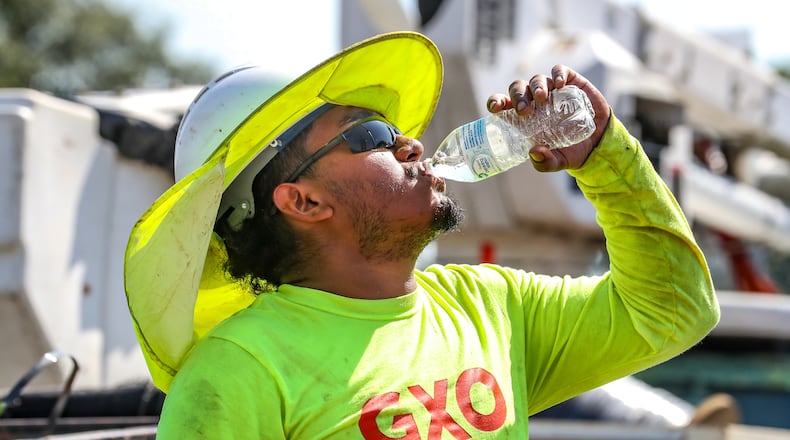A heat dome parked over the central U.S. is bringing days of dangerous temperatures to Atlanta and much of state this week, with little relief in sight until the weekend.
Temperatures on Monday reached the mid-to-high 90s across much of eastern and central Georgia, with “feels like” temperatures between 105 and 108 degrees, leading the National Weather Service’s (NWS) Atlanta office to issue a heat advisory for many Metro Atlanta counties.
The rest of the week could be even worse.
Afternoon highs are expected to approach triple digits on Tuesday. The potential for extreme heat is even higher on Wednesday, Friday and Saturday, before an expected cool-down on Sunday. In response, the city of Atlanta is opening a cooling center for residents who need relief, from 11 a.m. to 6 p.m. daily at the Selena Butler Facility located at 98 William Holmes Borders Senior Drive SE.
This kind of heat isn’t just uncomfortable — it can be deadly. And human-caused climate change is making these events more likely and intense.
Here’s what you need to know to stay safe.
Heat can kill
Hurricanes and tornadoes leave behind a trail of tragedy and destruction that is easily captured in headlines and images. But compared to other natural disasters, extreme heat is actually the Number One killer in the U.S.
Heat contributes to an average of 702 deaths in the U.S. each year, according to the Centers for Disease Control and Prevention, though many experts say the actual death toll is likely much higher. One study published in 2020 found roughly 12,000 premature deaths each year in the U.S. are linked to heat exposure.
Those most at-risk of complications include children, the elderly, pregnant women and those with certain medical conditions, like heart and lung issues, the CDC says. Outdoor workers, athletes and those experiencing homelessness are also more vulnerable.
Credit: Miguel Martinez/AJC
Credit: Miguel Martinez/AJC
Furry friends aren’t immune to the dangers of heat, either. Experts say to keep pets inside as much as possible. And if you do need to walk your dog, keep them off of hot pavement or put dog shoes on them to avoid burning their paws.
If you must venture outside for work or other activities, the CDC recommends adjusting your schedule to do so when temperatures are cooler, such as the morning or evening. Exercising in the heat can also be dangerous, especially if your body is not accustomed to high temperatures. Make sure you’re well-hydrated and wearing loose, lightweight clothing to allow your body to cool down.
Lastly, watch out for signs of heat exhaustion, which can include headaches, nausea, profuse sweating, dizziness and confusion.
Some neighborhoods are more at risk
Across a city the size of Atlanta, heat risk can vary greatly from block to block and even house to house.
Areas shaded by trees are cooler than ones dominated by buildings and heat-absorbing pavement. Typically, those parts of the city with less vegetation are home to more lower-income residents and communities of color.
A recent landmark analysis conducted by the climate consulting group, Urban Adapt LLC, and commissioned by two Atlanta City Councilmembers, found that Atlanta’s heat risk is the most acute in neighborhoods south and west of Downtown. Those include historic Black neighborhoods like English Avenue and Pittsburgh.
Generally speaking, those neighborhoods have less tree cover and more heat-trapping concrete than other parts of the city. Adding to the risk is the lack of central air conditioning in many homes, the study found. That, combined with the older average age of residents, creates an outsized heat risk in neighborhoods around the city’s urban core.
The good news is there are solutions to the problem.
The researchers found that targeted tree plantings and installing reflective roofs in the most vulnerable areas could significantly bring temperatures down. Tree advocates have said those strategies must also be paired with new regulations that preserve the city’s existing tree canopy, which has been in decline for years.
It is not clear what Mayor Andre Dickens’ office or City Council will do with the report’s recommendations.
Climate change is making heat more intense
Short-term weather patterns are partly behind this week’s extreme heat, but climate change is also to blame.
Scientists have known for years that as the planet warms — mainly due to emissions of greenhouse gases from the burning of fossil fuels — heat waves, like this one, are expected to grow more frequent, intense and long-lasting.
Atlanta is no exception.
Average temperatures in Atlanta have climbed about 3 degrees since 1930, with similar increases observed in other parts of the state. Atlanta also experiences about six more heat waves — a stretch of two or more days with abnormally warm temperatures — each year than it did 60 years ago, according to an analysis of federal data. Both trends are expected to continue.
This week’s heat comes during what could ultimately rank as Earth’s hottest summer on record.
Federal scientists announced last week that July was likely Earth’s hottest month ever recorded. It came on the heels of the hottest June the planet has experienced in 174 years.
The extreme heat has strained power grids, fueled devastating wildfires in Canada and bleached coral reefs off the Florida coast.
A note of disclosure
This coverage is supported by a partnership with 1Earth Fund, the Kendeda Fund and Journalism Funding Partners. You can learn more and support our climate reporting by donating at ajc.com/donate/climate/
About the Author
Keep Reading
The Latest
Featured




